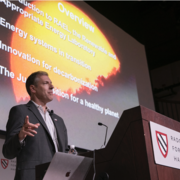
In Radcliffe talk, professor says science must join with social, policy evolution to create ‘a just transition’
By Clea Simon, the Harvard Gazette
Even as climate change reaches new and terrifying levels, hope remains — but the time to act is now.
That was the message Professor Daniel M. Kammen brought to a lecture in the Undiscovered Science series at Radcliffe Institute on Monday. Even before he began his talk, “An Energy Plan the Earth Can Live With,” he took a moment to stress the problem’s scope.
“We are at a point where a call for ‘a just transition’ is more accurate than ‘an energy plan,’” said Kammen, the Class of 1935 Distinguished Professor of Energy and chair of the Energy and Resources Group at the University of California, Berkeley. “We have to make this great energy transition, but we are moving too slowly.”
The clock is ticking. Last October, the Intergovernmental Panel on Climate Change (IPCC), which shared the Nobel Peace Prize in 2007, issued a statement about the need to hold additional global warming to less than 1.5 degrees Celsius. (Humans have already warmed the planet 1 degree Celsius.) But as emerging economies pursue growth and the Trump administration denies climate change, that objective is growing increasingly elusive.
During his address, Kammen, who has been the coordinating lead author for the IPCC since 1999 and is a professor in the Goldman School of Public Policy and its Department of Nuclear Engineering, not only spoke of the scientific advances that can make such goals achievable, but addressed the social and policy evolution that must go hand in hand with the technology.
“If we don’t think about ways to do this better, then we make our job impossibly hard.”
— Daniel M. Kammen
“We know we need to meet this climate target,” but too often the problem is incentive, he said. “Humans are very poor at any kind of decision-making that isn’t focused on money.”
To foster the needed change, Kammen cited the ongoing work of Berkeley’s Renewable and Appropriate Energy Laboratory, which takes a multidisciplinary approach to research and implementation. In its 10-plus years, the research group, which Kammen founded and now directs, has increasingly drawn people not only from STEM backgrounds but from philosophy and the social sciences.
Kammen said science and social change often work together. New technologies, like flexible and even wearable solar panels, make renewable energy both cheaper and easier to access, and with them many countries are doing more than their share in the battle. Morocco, for example, has become a leader in climate policy, while Kenya has the Ngong Hills Wind Power Station.
On a micro level, lightweight and cheaper technologies are helping sub-Saharan Africa leapfrog over traditional signs of progress, as exemplified by the solar-powered lights that are phasing out kerosene lanterns. Some impetus for change is simple economics: although the traditional fuel-burning lanterns are initially cheaper than other options, they come with ongoing costs in terms of the need for fuel, as well as the price paid by the environment. As new programs promote solar devices, allowing users to pay them off over time (and connecting with users via text messages), lights that incorporate radios, as well as solar-powered appliances, such as refrigerators, are becoming popular, lessening the need for a traditional power grid.
“Low-cost, solar-powered, home-energy products are transforming rural energy access,” said Kammen.
In America, Kammen said a “Green New Deal” must lead to a “much bigger discussion about equity.” For example, although 16 states have passed laws to enable alternative clean energies, too often these simply focus on subsidizing changes made by homeowners, he said. The efforts also tend to target only one group, viewed as more likely to modify or build for energy efficiency.
“Even when you control for income, solar is 30 percent to 40 percent more prevalent in white/Caucasian-dominated” communities, Kammen said. And since such legislation relies on taxpayer money, in effect it “borrows money from all to pay those who are better off,” he said. The result is alternative energy inequality. Though the laws are well-meaning, they ignore the exponentially higher price communities of color pay in terms of health and wellness because of climate change.
Instead, Kammen said, we need to devise plans to disperse benefits to more than only homeowners. Legislation aimed at landlords or community groups could make the move to renewables more equitable, for example, as would redistributing a greater share of the benefits to disadvantaged communities.
“If we don’t think about ways to do this better,” said Kammen, “then we make our job impossibly hard.”